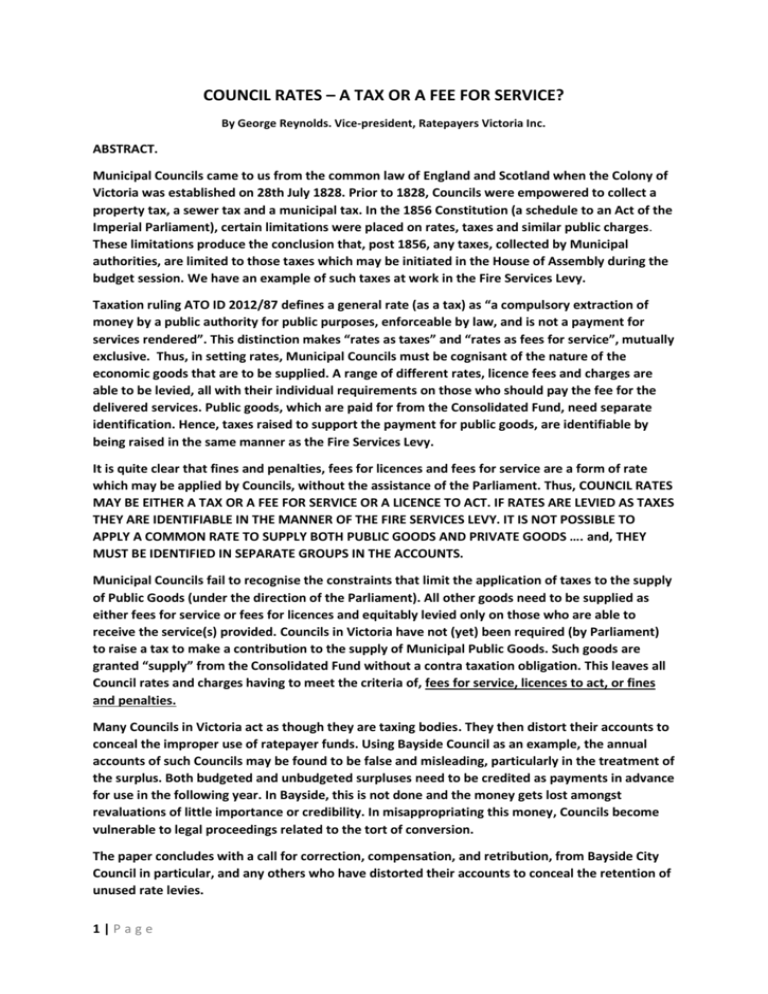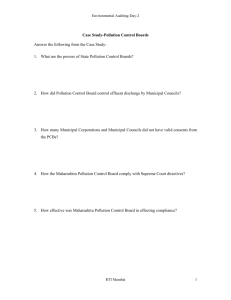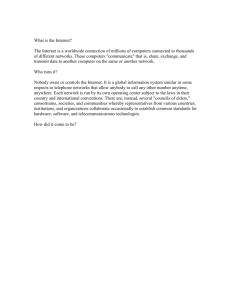council rates paper
advertisement

COUNCIL RATES – A TAX OR A FEE FOR SERVICE? By George Reynolds. Vice-president, Ratepayers Victoria Inc. ABSTRACT. Municipal Councils came to us from the common law of England and Scotland when the Colony of Victoria was established on 28th July 1828. Prior to 1828, Councils were empowered to collect a property tax, a sewer tax and a municipal tax. In the 1856 Constitution (a schedule to an Act of the Imperial Parliament), certain limitations were placed on rates, taxes and similar public charges. These limitations produce the conclusion that, post 1856, any taxes, collected by Municipal authorities, are limited to those taxes which may be initiated in the House of Assembly during the budget session. We have an example of such taxes at work in the Fire Services Levy. Taxation ruling ATO ID 2012/87 defines a general rate (as a tax) as “a compulsory extraction of money by a public authority for public purposes, enforceable by law, and is not a payment for services rendered”. This distinction makes “rates as taxes” and “rates as fees for service”, mutually exclusive. Thus, in setting rates, Municipal Councils must be cognisant of the nature of the economic goods that are to be supplied. A range of different rates, licence fees and charges are able to be levied, all with their individual requirements on those who should pay the fee for the delivered services. Public goods, which are paid for from the Consolidated Fund, need separate identification. Hence, taxes raised to support the payment for public goods, are identifiable by being raised in the same manner as the Fire Services Levy. It is quite clear that fines and penalties, fees for licences and fees for service are a form of rate which may be applied by Councils, without the assistance of the Parliament. Thus, COUNCIL RATES MAY BE EITHER A TAX OR A FEE FOR SERVICE OR A LICENCE TO ACT. IF RATES ARE LEVIED AS TAXES THEY ARE IDENTIFIABLE IN THE MANNER OF THE FIRE SERVICES LEVY. IT IS NOT POSSIBLE TO APPLY A COMMON RATE TO SUPPLY BOTH PUBLIC GOODS AND PRIVATE GOODS …. and, THEY MUST BE IDENTIFIED IN SEPARATE GROUPS IN THE ACCOUNTS. Municipal Councils fail to recognise the constraints that limit the application of taxes to the supply of Public Goods (under the direction of the Parliament). All other goods need to be supplied as either fees for service or fees for licences and equitably levied only on those who are able to receive the service(s) provided. Councils in Victoria have not (yet) been required (by Parliament) to raise a tax to make a contribution to the supply of Municipal Public Goods. Such goods are granted “supply” from the Consolidated Fund without a contra taxation obligation. This leaves all Council rates and charges having to meet the criteria of, fees for service, licences to act, or fines and penalties. Many Councils in Victoria act as though they are taxing bodies. They then distort their accounts to conceal the improper use of ratepayer funds. Using Bayside Council as an example, the annual accounts of such Councils may be found to be false and misleading, particularly in the treatment of the surplus. Both budgeted and unbudgeted surpluses need to be credited as payments in advance for use in the following year. In Bayside, this is not done and the money gets lost amongst revaluations of little importance or credibility. In misappropriating this money, Councils become vulnerable to legal proceedings related to the tort of conversion. The paper concludes with a call for correction, compensation, and retribution, from Bayside City Council in particular, and any others who have distorted their accounts to conceal the retention of unused rate levies. 1|Page THIS PAGE IS LEFT BLANK ON PURPOSE 2|Page INTRODUCTION; MUNICIPAL COUNCILS IN VICTORIA. Municipal Councils came to us from the common law of England and Scotland when the colony of Victoria was established on 28th July 1828. The laws establishing the rights and obligations of such councils passed into the laws of Victoria when the State Constitution was enacted in 1856. When the Federal Constitution was established in 1900 there was no attempt to change the status of Municipal Bodies as departments of State governments. Prior to 1828, councils were empowered to collect a land tax, a sewer tax and a municipal tax. The land tax was collected from the land owner; the sewer and municipal taxes were collected, in the form of rates, from the occupier. (Note that in England the sewers also carried the storm water) Overdue and unpaid rates were collectible in the same manner as unpaid rents. In the 1856 Constitution (a schedule to an Act of the Imperial Parliament), certain limitations were placed on rates, taxes and similar public charges. Notably: No public taxes, rates or charges were to be deemed to be an Incumbrance or charge over any land. (Art XV). All taxes, imposts, rates and duties … shall form one consolidated revenue, to be appropriated for the Public Service of the Colony of Victoria. (Art XLIV). All bills for appropriating any part of the Revenue of Victoria, and for imposing any duty, rate, tax rent return or impost shall originate in the Assembly. (Art LVI). It is not lawful for the Assembly to pass any bill for the appropriation from the Consolidated Fund unless first recommended by message from the Governor during the session when the bill is to be passed. (Art LVII). The property tax was reserved to the State and is now represented by Land Tax. These limitations produce the conclusion that, post 1856, any rates as taxes, collected by Municipal authorities, are limited to those taxes which may be initiated in the House of Assembly during the budget session. A corollary to this is that Municipal Authorities are not independent taxing bodies. If they are to collect revenue in the form of rates or taxes, the authority to do so must be initiated in the Assembly and eventually approved by the Legislative Council. The revenue collected by such taxes must be deposited in the Consolidated Fund. Any payments to Municipal Councils (from the Fund) must be identified and authorised in the annual Budget Session of Parliament. We have an example of such taxes at work in the Fire Services Levy. It is initiated in the Assembly, collected by a Municipal Council and is to be paid into or on behalf of the Consolidated Fund. The total payment is allocated in the annual budget to the fire services for their discretionary use. Note that it is not a fee for any service rendered. RATES WHICH ARE TAXES. A recent document which looks at this question is in taxation ruling ATO ID 2012/87. It quotes from an earlier 1904 decision from the High Court of Australia, where it was stated: Municipal Councils were an administrative body of the State, and Municipal Rates were a tax applied by the State, and The Australian Constitution barred the States from taxing Commonwealth land. 3|Page The ATO ruling, most notably defines a general rate, being a tax, as “a compulsory extraction of money by a public authority for public purposes, enforceable by law, and is not a payment for services rendered”. This distinction makes “rates as taxes” and “rates as fees for service”, mutually exclusive. To add further to this distinction, the ruling further quotes from the HCA decision: “the Statute operates as a delegation of the taxing power of the State, coupled with a direction when and how to use it”. Hence, money raised by a public authority for the supply of public goods may be raised from taxation. However the power must be delegated by the State, (to an individual or office) with an instruction on when and how it is to be used. Proceeds must also be delivered into the Consolidated Fund. Payments from this fund are then authorised by a delegation, ( from the State Treasurer?) for whatever specific purpose (even a general purpose) that the Parliament decides. Currently, Councils receive payments from the Consolidated Fund for nominated (public) purposes. There is, at present, no rate levied which is payable to or on behalf of, the Consolidated Fund. However, Councils collect the Fire Services Levy. This is on-sent, through the Consolidated Fund, to be used for the discretionary purposes of the fire and rescue authorities. (Council cannot use this money even if it sets up its own Fire Service). RATES WHICH ARE NOT TAXES. The alternative form, rates as payments for services rendered, by definition, provides for private goods. The service is targeted to the (private) user and must be accessible “to those members of the community for whom the service is intended”. (Note s208B(c) of the LGA). Hence, this form of rate is targeted at sectors of the community, and sub-groups in the community who are able to benefit from it – and must pay for it. In setting rates, Municipal Councils must be cognisant of the nature of economic goods that are be supplied. A range of different rates, licence fees and charges are able to be levied – all with their individual restrictions on who should pay. From the perspective of a Municipal Council, the HCA decision has broader implications. It inhibits Councils from claiming that they are a third and separate tier of Government. It also suggests that Councils need the support of Parliament - in budget session – to raise General Rates in the form of a tax. Since the 1904 decision, the issue of which rates and charges are not taxes has been clearly defined in the Constitution Act 1975. While this Act, at s62, reiterates the limitations of Art LVI of the Constitution, it also lists, at s64, those charges which “shall not be taken to be a bill …. for imposing any duty rate rent return or impost.., “ i.e. it lists those rates and charges which are not to be considered as taxes. It is quite clear that fines and penalties, fees for licences and fees for service are a form of rate which may be applied by Councils, without the assistance of the Parliament. Thus, COUNCIL RATES MAY BE EITHER A TAX OR A FEE FOR SERVICE OR A LICENCE TO ACT. IF RATES ARE LEVIED AS TAXES THEY ARE IDENTIFIABLE IN THE MANNER OF THE FIRE SERVICES LEVY. IT IS NOT POSSIBLE TO APPLY A COMMON RATE TO SUPPLY BOTH PUBLIC GOODS AND PRIVATE GOODS. 4|Page ECONOMIC GOODS – THE TEST TO SELECT WHERE TO SEND THE BILL! (Based on the work of Comrie, Smirl and Sody, Reference 1.) The concept of the nature of economic goods may be used to distinguish the separate nature of mutually exclusive forms of rates and charges, applied by Municipal Councils. It is possible to conclude that general rates, applied for the purpose of the supply of public goods, to all rateable land, may be levied by an ad valorem tax on that land. As taxes, such rates raised must follow the processes in s62 of the Constitution Act 1975. Conversely, a general rate, applied for the supply of private community goods, to the rateable land, may be seen as fees for service to that specific community. Rates are collectible by levy from those able to benefit from the service, e.g. a garbage rate is collectible only from those able to access the service. Most importantly, the cost to supply the service is estimated and is then shared, for example, in proportion to the individual property values, related to the total of all participating property values. Public goods are easily identified, as are licences to act or occupy. Private goods are more varied as the term can apply to whole communities, sectors of communities, different interest groups and individuals. Public Goods are supplied for the benefit of all citizens and residents within the State. Equity demands that it should not matter which municipality supplies the goods, the quality and quantity of service should be common between recipients. The equality should be provided by a common tax or rate being used to collect revenue to be paid into the Consolidated Fund. Payment from the fund (controlled by the State Treasurer) should be on a needs basis and not vary between municipalities. The fire services levy meets these standards. Welfare services are a good example of Public Goods Private Goods are many and varied but may be classified by usage, into: Private Property Goods are goods which, when supplied, benefit the property. Connections from the property such as roads and drains represent examples. Rates based on the Capital Improved Value (CIV) is an equitable form of service levy. Note that arterial roads meet the definition of public goods, yet toll roads are private goods - as are local roads. Private Occupier Goods are those which bring a benefit to the occupier of the property. The examples are libraries, parks and open spaces, municipal buildings etc. Rates based on a common charge per unit of occupation is an equitable form of levy. However, it is common to (unfairly) use the CIV system. (The CIV system rapidly becomes inequitable where high value properties have few occupiers, e.g. recently rezoned land). When rates first came to Victoria, the rental value of the land – for the purpose for which it is used – was the common levy base. (Early rate records listed the occupier; the identity of the owner was frequently not recorded). Importantly, the LGA, at s158A, states that rates and charges (are) to be levied on each occupancy. Private Personal Goods are those which bring a benefit to individuals and groups. There are three sub-groups: 5|Page Private personal goods which benefit a group of landowners, e.g. a local roadmaking scheme, and Private personal goods which bring a benefit of choice to some occupiers, e.g. Christmas decorations, car parking schemes, etc., and Private personal goods which bring a benefit to organisations whose members are not necessarily ratepayers, such as sporting clubs, social groups and community commercial activities such as kindergartens. Private Personal Goods obviously require Special Rates and Special Charges to be applied, to deal with the financing. However, where the members are not necessarily ratepayers, the “licence to occupy” is a more appropriate method. Note also, the ability of Municipal Enterprises to supply services to non-rateable customers. RATING PRACTICE. The Local Government Act 1989 (The LGA) and the Constitution Act 1975, between them, provide a flexible and reasonable set of rates and charges which may be applied to support the work of Local Government. There is, in the LGA, a directive for such rates and charges to be equitably applied. Section 3C(2)(e) and (f) of the LGA imposes the obligation: To ensure that services and facilities provided by Council are accessible and equitable, and To ensure the equitable imposition of rates and charges. Division 1 of Part 8 of the LGA provides all the flexibility needed to achieve the objective of equity between the many groups and individuals who, of necessity, must deal with their Municipal Council. On the other hand, Councils claim the omnipotence of being a tier of government with the right to raise rates, as taxes, at will. It is clear that: Municipal Councils fail to recognise the constraints that limit the application of taxes to the supply of Public Goods under the direction of the Parliament. All other goods, need to be supplied as either fees for service or fees for licences. Such rates and charges are to be equitably levied, only on those who are able to access the service(s) provided. THE CONSOLIDATION OF SERVICE AND USAGE FEES INTO A SINGLE RATE IS INEQUITABLE. COUNCIL PRACTICE. The LGA establishes a system of governance able to handle the wide range of tasks that Councils are required to carry out. To provide flexibility, the Act is permissive rather than directive. The term “may” is widely used, rather than “must”. This is fertile ground for the devious and dishonest. Simply by ignoring the conditions precedent to an action, Councils claim they have lawful permission to carry out an action or activity. Bayside Council, for example, claims the universal right to apply a tax. This of course ignores the precedent condition, that taxes must be initiated in the Parliament. The attitude of Bayside (and many others, including Local Government Victoria) avoids consideration of s3D of the LGA – the powers of Council are “subject to any limitations or restrictions imposed by or under … any other Act”. The attitude – all rates have the flexibility of taxes – leads Bayside Council into serious problems. Essentially, its accounts may be readily shown to be misleading; the accounts don’t balance, they omit significant items of expenditure, they provide for expenditure on items that have already been provided for and conceal the accumulation of a surplus “slush fund”. Bayside Council, with many others, provides services which are able to be financed by a range of different rates and charges. The services which provide for Public Goods - and paid for from the Consolidated Fund – are provided as a grant directly to the cost centre providing the service. For example, Council provides a commercial service to supply meals, house cleaning, personal care etc., on a fee for service basis. It publishes the standard fee for the service. For eligible members of the 6|Page public, however, the fees are subsidised by a grant from the State. Each year, the residual fee to be paid to Council for this service, for eligible beneficiaries, is also published. Council accounts ought then to be able to demonstrate the equity of the arrangement. This accounting task is not carried out with transparency. Councils are not required to raise a tax to provide for the supply of Municipal Public Goods in the State of Victoria. This leaves all other rates and charges having to meet the criteria, of fees for service, licences to act or fines and penalties. An additional revenue source, the Municipal charge is also permissible, to deal with the cost of administration. iT is limited to 25% of the general rate. Other revenue may be obtained from the conduct of municipal enterprises. THE FUNCTION OF THE SURPLUS Many, if not all Councils in Victoria, act as though they are taxing bodies, able to collect a profit in the form of a budget surplus. They then distort their accounts to conceal the improper accumulation of this tithe on the rate collection. It is done, in Bayside, by retaining the surplus yet taking it into the balance sheet as an accumulated asset – similar to a revaluation profit. In a taxing body such as a government, the budget is set to produce either a surplus or deficit. The quantum of the actual surplus is retained and generally used to reduce the National Debt. Conversely, the deficit is provided for, by adding to the debt (selling Government Bonds). Hence Income – Expenditure – Surplus = 0.The amount of the surplus will be equal to the value of Bonds redeemed (and provided for in the National Accounts). In municipal governance, however, there is no provision able to be made for a deficit. The provision made, when spending is likely to exceed the budget allowance, is to prepare a revised budget (s128 (1)). To reduce the likelihood of the need for a revised budget, it is considered ‘prudent’ to aim for a surplus to be collected from the appropriate rate. The Victorian Auditor General Office (VAGO) publishes a recommendation of “greater than 0%”. There is no upper limit. Most municipalities collect both a budgeted surplus and an unbudgeted one – when the final cost is lower than the estimated cost. There is a provision in the LGA, at s165, to deal with a surplus of this type. While this relates to a cash refund for ventures which have a finite duration, it also points to the correct accounting treatment for surplus accumulation. Hence: Both budgeted and unbudgeted surpluses need to be credited as payments owed to the ratepayer. It may be accounted for as an “in advance” payment for the following year. To do otherwise, Councils become vulnerable to legal proceedings related to the tort of conversion. A separate note looks at the 2014 accounts of Bayside City Council and questions the credibility of the council publication. CORRECTION AND RETRIBUTION Municipal Councils are in default of their obligations under the Constitution Act and the Local Government Act. They claim to be a government but are an administration managing a (mainly) fee for service enterprise. To provide correction and retribution, this group of ratepayers seek the following: The forensic examination of all Council accounts to ensure that they meet the definition of “proper accounts” in s140 of the LGA, and; 7|Page The suspension of any Council found to have prepared, issued and approved accounts which are found, after forensic examination, to be deficient, false or misleading, and; The appointment of Commissioners to administer all Councils so determined, until Council, and Councillors wishing to serve on the audit committee, demonstrate an understanding of how to produce “proper” accounts, and; The return of all funds misapplied by Councils, and still retained, to be credited as prepayments on future lawful rate demands, and; Compensation to ratepayers to be paid from the professional liability protection facility of Councils to restore the damage caused to individuals and organisations by the application of rate demands for years when subsequent accounts have been calculated using false or misleading accounts, and; Compensation to ratepayers to be paid by auditors found to have collected professional fees from the certification of false and misleading accounts of Municipal Councils, and; Review by the appropriate regulatory authority of the certification of auditors who declared misleading accounts “true and fair”, and; Review of the 2014 Regulations to ensure that accounts deal separately with different rating and contribution groups, to ensure that rates, charges and fees are equitably applied without cross subsidisation between the different forms of economic goods produced, and; The establishment of an independent administrator (or similar), to ensure the interests of ratepayers are protected throughout Victoria. End of document; Author George Reynolds; COUNCIL RATES PAPER; Date 150215; Rev 6. Attachment 1. Comprehensive Income Account; Bayside City Council 2014. Reference 1. Comry, Smirl and Sody. Rating Policies – an ad hoc or principled balancing act? Source unknown but ex Local Government Victoria. 8|Page






